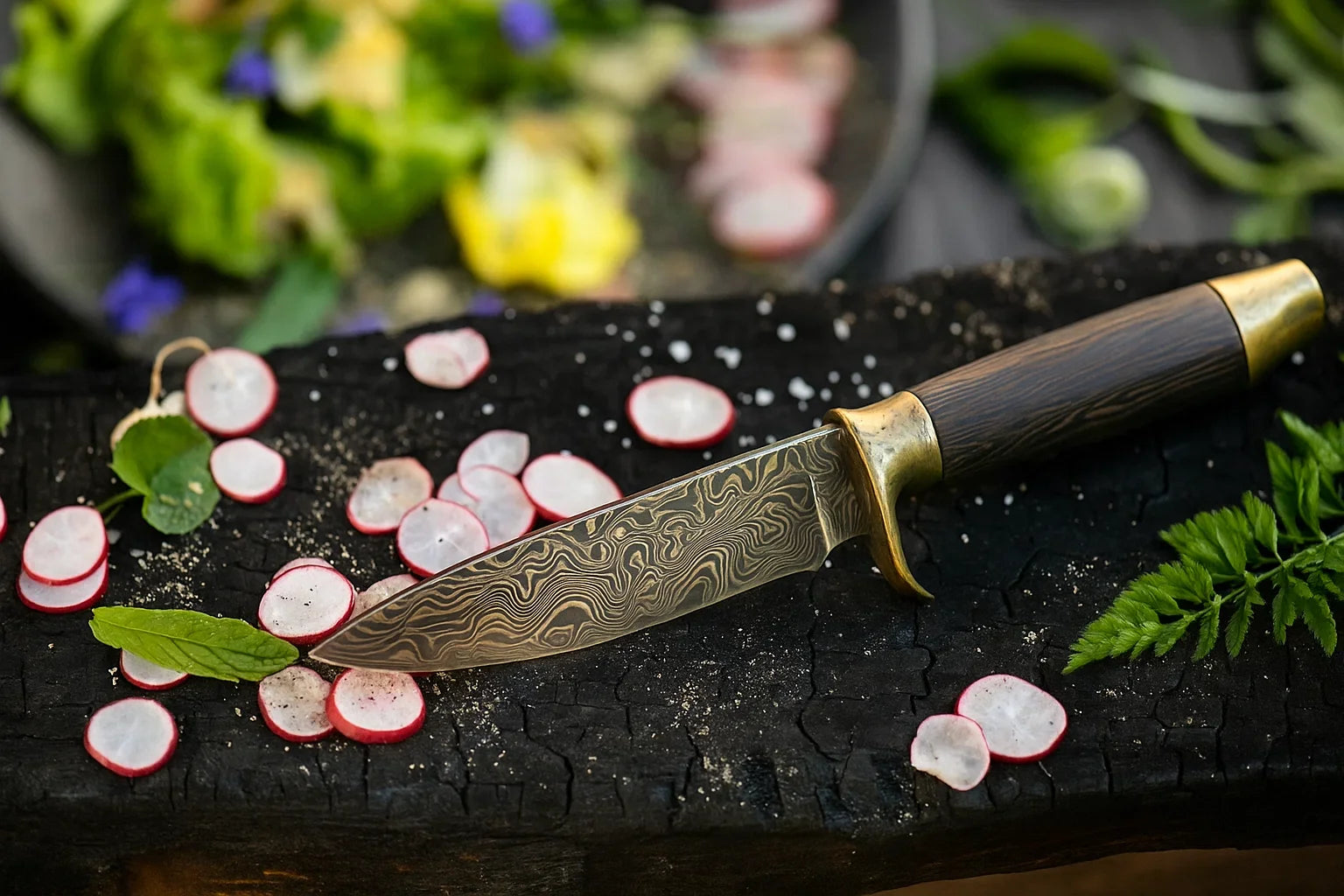Your Cart is Empty
FREE SHIPPING FOR USA

Why Damascus Knives Are a Premium Investment for Modern Bladesmiths, Chefs, and Collectors
Damascus steel, famed for its mesmerizing patterns and exceptional strength, has captivated bladesmiths, chefs, and knife collectors for centuries. But what exactly is Damascus steel, why is it priced at a premium, and how does a modern knife crafted with this ancient technique serve both form and function?
In this guide, we’ll explore the history, manufacturing process, performance characteristics, and the real-world value of Damascus steel knives—with a special focus on how Jun Knives honors this legendary craft.
Damascus steel refers to a forging technique that produces layered patterns resembling flowing water or swirling smoke. These blades were originally produced using Wootz steel, a high-carbon crucible steel exported from South Asia and forged in the Middle East—particularly around Damascus, Syria, hence the name.
Entity Disambiguation: “Damascus steel” in modern usage typically refers to pattern-welded steel, not original Wootz.
Exceptional hardness and edge retention
Flexibility under pressure (resisting fractures)
Iconic, visible grain structure unique to each blade
Often used in Middle Eastern swords prized by royalty and warriors
Though the ancient Wootz process was lost, today’s Damascus blades replicate its spirit using advanced metallurgy and artisanal techniques.
Damascus knives aren’t stamped or mass-produced. They’re hand-forged through a multi-step, artisan-led process, making each piece inherently unique.
Steel Selection
Bladesmiths start with multiple steels (e.g., 1095 high-carbon and 15N20 nickel alloy) that offer contrasting hardness and flexibility.
Forge Welding
Layers are stacked, heated, and forge-welded into a billet at temperatures exceeding 2,000°F.
Folding and Forging
The billet is folded and re-hammered repeatedly—this builds strength and forms the signature Damascus pattern.
Pattern Development
The steel is etched in acid to reveal the contrast between the steels, producing bold, organic designs.
Heat Treatment & Tempering
The blade is hardened and tempered to balance edge retention and toughness.
Sharpening & Finishing
Each blade is hand-sharpened and polished to a razor edge.
Some high-end Damascus knives, including those from Jun Knives, use powder metallurgy—a precision method where metal powders are fused under high pressure. This allows tighter grain control and stronger molecular bonding.
Modern stainless steel knives (such as 440C or AUS-8) are often mass-produced, functional, and easy to maintain—but they lack the performance edge and artistry of Damascus.
| Feature | Damascus Steel | Stainless/Standard Steel |
|---|---|---|
| Appearance | Unique, patterned | Plain, uniform |
| Edge Retention | Excellent | Moderate |
| Toughness | High (flexible spine) | Varies |
| Production | Hand-forged | Often stamped or CNC-cut |
| Longevity | Decades with care | 2–5 years average |
| Value | Premium investment | Low upfront cost |
Takeaway: Damascus knives aren’t just tools—they’re heirlooms.
Each knife can take dozens of hours to complete. Folding, forging, and finishing require highly trained artisans with years of experience.
Multiple steels are selected for contrast in hardness and flexibility. These are often more expensive and difficult to work with than standard stainless.
No two Damascus blades are alike. Patterns vary with every fold—resulting in a functional piece of art.
Because of the time and expertise required, Damascus knives are not mass-produced, making them rare and exclusive.
At Jun Knives, we merge traditional forging techniques with modern innovation to produce some of the finest Damascus knives available. Our process honors the old ways while embracing new technology—like powder metallurgy and cryogenic heat treatments.
Our handles are crafted from stabilized hardwood, micarta, or even fossilized woods, offering balance, durability, and grip.
Professional chefs who demand edge retention and control
Collectors who value originality and craft
Outdoor and bushcraft users needing durability and performance
Proper care extends the life of your Damascus blade and keeps it performing at its best.
Maintenance Tips:
Hand wash only—never put in the dishwasher
Dry immediately after use
Sharpen with a whetstone, not an electric sharpener
Apply a light coat of mineral oil before storing
Store in a dry environment, ideally in a sheath or knife block
Whether you’re a:
Culinary professional
Knife enthusiast or collector
Survivalist or outdoorsman
Home chef wanting a long-term upgrade
Damascus steel offers an unmatched combination of sharpness, toughness, and beauty, thanks to its layered construction and forging technique.
For edge retention, strength, and visual appeal—yes. However, Damascus requires more maintenance to protect its pattern and prevent rust.
Yes. Damascus made with high-carbon steel can rust if not properly maintained. Regular drying and oiling will prevent corrosion.
Authentic Damascus will show depth and variation in its pattern. If the blade has a printed or etched design with no textural variation, it’s likely fake.
With proper care, a Damascus knife can easily last decades—often becoming a family heirloom.
Damascus steel is more than just a high-performance alloy—it’s a story. A story of craftsmanship, culture, metallurgy, and artistry. Whether you’re slicing in a kitchen or collecting for display, a Damascus blade brings depth, precision, and personality to your toolkit.
At Jun Knives, we honor that legacy with every piece we forge. Explore our Damascus collection and see why craftsmanship still matters.